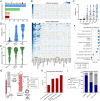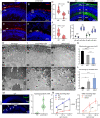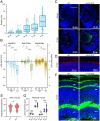Specialization of the photoreceptor transcriptome by Srrm3-dependent microexons is required for outer segment maintenance and vision
- PMID: 35858306
- PMCID: PMC9303857
- DOI: 10.1073/pnas.2117090119
Specialization of the photoreceptor transcriptome by Srrm3-dependent microexons is required for outer segment maintenance and vision
Abstract
Retinal photoreceptors have a distinct transcriptomic profile compared to other neuronal subtypes, likely reflecting their unique cellular morphology and function in the detection of light stimuli by way of the ciliary outer segment. We discovered a layer of this molecular specialization by revealing that the vertebrate retina expresses the largest number of tissue-enriched microexons of all tissue types. A subset of these microexons is included exclusively in photoreceptor transcripts, particularly in genes involved in cilia biogenesis and vesicle-mediated transport. This microexon program is regulated by Srrm3, a paralog of the neural microexon regulator Srrm4. Despite the fact that both proteins positively regulate retina microexons in vitro, only Srrm3 is highly expressed in mature photoreceptors. Its deletion in zebrafish results in widespread down-regulation of microexon inclusion from early developmental stages, followed by other transcriptomic alterations, severe photoreceptor defects, and blindness. These results shed light on the transcriptomic specialization and functionality of photoreceptors, uncovering unique cell type-specific roles for Srrm3 and microexons with implications for retinal diseases.
Keywords: alternative splicing; retinal disease model; zebrafish.
Conflict of interest statement
The authors declare no competing interest.
Figures






Similar articles
-
Mutations in the microexon splicing regulator srrm4 have minor phenotypic effects on zebrafish neural development.G3 (Bethesda). 2025 May 8;15(5):jkaf052. doi: 10.1093/g3journal/jkaf052. G3 (Bethesda). 2025. PMID: 40053833 Free PMC article.
-
The ciliopathy gene cc2d2a controls zebrafish photoreceptor outer segment development through a role in Rab8-dependent vesicle trafficking.Hum Mol Genet. 2011 Oct 15;20(20):4041-55. doi: 10.1093/hmg/ddr332. Epub 2011 Aug 4. Hum Mol Genet. 2011. PMID: 21816947 Free PMC article.
-
Emc1 is essential for vision and zebrafish photoreceptor outer segment morphogenesis.FASEB J. 2024 Oct 15;38(19):e70086. doi: 10.1096/fj.202401977R. FASEB J. 2024. PMID: 39360639
-
From Tiny Exons to Big Insights: The Expanding Field of Microexons.Annu Rev Genomics Hum Genet. 2025 Aug;26(1):77-102. doi: 10.1146/annurev-genom-121323-103648. Epub 2025 May 20. Annu Rev Genomics Hum Genet. 2025. PMID: 40393474 Review.
-
The genetics of outer segment morphogenesis in zebrafish.Adv Exp Med Biol. 2012;723:431-41. doi: 10.1007/978-1-4614-0631-0_55. Adv Exp Med Biol. 2012. PMID: 22183362 Review. No abstract available.
Cited by
-
A highly conserved neuronal microexon in DAAM1 controls actin dynamics, RHOA/ROCK signaling, and memory formation.Nat Commun. 2025 May 6;16(1):4210. doi: 10.1038/s41467-025-59430-w. Nat Commun. 2025. PMID: 40328765 Free PMC article.
-
Regulated microexon alternative splicing in single neurons tunes synaptic function.EMBO Rep. 2025 Jul;26(14):3640-3662. doi: 10.1038/s44319-025-00493-7. Epub 2025 Jun 9. EMBO Rep. 2025. PMID: 40490601 Free PMC article.
-
Regulation of alternative splicing and polyadenylation in neurons.Life Sci Alliance. 2023 Oct 4;6(12):e202302000. doi: 10.26508/lsa.202302000. Print 2023 Dec. Life Sci Alliance. 2023. PMID: 37793776 Free PMC article. Review.
-
The Musashi proteins direct post-transcriptional control of protein expression and alternate exon splicing in vertebrate photoreceptors.Commun Biol. 2022 Sep 24;5(1):1011. doi: 10.1038/s42003-022-03990-w. Commun Biol. 2022. PMID: 36153373 Free PMC article.
-
Metabolic transcriptomics dictate responses of cone photoreceptors to retinitis pigmentosa.Cell Rep. 2023 Sep 26;42(9):113054. doi: 10.1016/j.celrep.2023.113054. Epub 2023 Aug 31. Cell Rep. 2023. PMID: 37656622 Free PMC article.
References
Publication types
MeSH terms
Substances
LinkOut - more resources
Full Text Sources
Molecular Biology Databases

